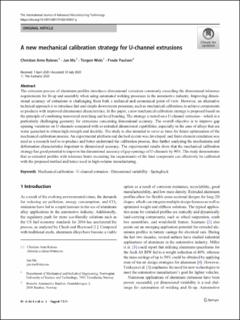| dc.contributor.author | Raknes, Christian Arne | |
| dc.contributor.author | Ma, Jun | |
| dc.contributor.author | Welo, Torgeir | |
| dc.contributor.author | Paulsen, Frode | |
| dc.date.accessioned | 2020-08-25T09:19:09Z | |
| dc.date.available | 2020-08-25T09:19:09Z | |
| dc.date.created | 2020-08-12T10:55:02Z | |
| dc.date.issued | 2020 | |
| dc.identifier.citation | The International Journal of Advanced Manufacturing Technology. 2020, . | en_US |
| dc.identifier.issn | 0268-3768 | |
| dc.identifier.uri | https://hdl.handle.net/11250/2673845 | |
| dc.description.abstract | The extrusion process of aluminum profiles introduces dimensional variations commonly exceeding the dimensional tolerance requirements for fit-up and assembly when using automated welding processes in the automotive industry. Improving dimensional accuracy of extrusions is challenging from both a technical and economical point of view. However, an alternative technical approach is to introduce fast and simple downstream processes, such as mechanical calibration, to achieve components or products with improved dimensional characteristics. In this paper, a new mechanical calibration strategy is proposed based on the principle of combining transversal stretching and local bending. The strategy is tested on a U-channel extrusion—which is a particularly challenging geometry for extrusions concerning dimensional accuracy. The overall objective is to improve gap opening variations on U-channels compared with as-extruded dimensional capabilities, especially in the case of alloys that are water quenched to obtain high strength and ductility. The study is also intended to serve as basis for future optimization of the mechanical calibration process. An experimental platform and die/tool system was developed, and finite element simulation was used as a research tool to re-produce and better understand the calibration process, thus further analyzing the mechanisms and deformation characteristics important to dimensional accuracy. The experimental results show that the mechanical calibration strategy has good potential to improve the dimensional accuracy of gap openings of U-channels by 90%. The study demonstrates that as-extruded profiles with tolerance limits exceeding the requirements of the final component can effectively be calibrated with the proposed method and hence used in high-volume manufacturing. | en_US |
| dc.language.iso | eng | en_US |
| dc.publisher | Springer | en_US |
| dc.rights | Navngivelse 4.0 Internasjonal | * |
| dc.rights.uri | http://creativecommons.org/licenses/by/4.0/deed.no | * |
| dc.title | A new mechanical calibration strategy for U-channel extrusions | en_US |
| dc.type | Peer reviewed | en_US |
| dc.type | Journal article | en_US |
| dc.description.version | publishedVersion | en_US |
| dc.source.pagenumber | 13 | en_US |
| dc.source.journal | The International Journal of Advanced Manufacturing Technology | en_US |
| dc.identifier.doi | https://doi.org/10.1007/s00170-020-05857-y | |
| dc.identifier.cristin | 1822928 | |
| dc.description.localcode | C The Author(s) 2020. Https://doi.org/10.1007/s00170-020-05857-y. This article is licensed under a Creative Commons Attribution 4.0 International License, which permits use, sharing, adaptation, distribution and reproduction in any medium or format, as long as you give appropriate credit to the original author(s) and the source, provide a link to the Creative Commons licence, and indicate if changes were made. | en_US |
| cristin.ispublished | true | |
| cristin.fulltext | original | |
| cristin.qualitycode | 2 | |

